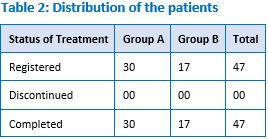A clinico comparative study on the role of Panchakarma and Physiotherapy in the management of Pristhgraha w.s.r. to cervical spondylosis
Keywords:
Ayurveda, Cervical spondylosis, Prishthagraha, Rasnasaptak Kwatha, Nasya, PhysiotherapyAbstract
Background: Cervical Spondylosis is the term given to the occurrence of osteoarthritis in the cervical spine. It is characterized by degeneration of the intervertebral discs and osteophyte formation. This is extremely common and radiological changes of cervical spondylosis are very frequently in apparently healthy individuals above the age of 50 years. In Ayurveda it has a high resemblance with Pristhagraha, which comes under Nanatmaja Vatavikara. Objectives: To study the effect of Pristh Basti, Nasya Karma and Rasnasaptak Kwath in the management of Pristhgraha (cervical spondylosis), to study the effect of Rasnasaptak Kwath and Physiotherapy in the management of Pristhgraha (cervical spondylosis) and to compare the effect of group-A & group-B in the management of Pristhgraha (cervical spondylosis). Material and Methods: In this study total 47 patients of Pristhagraha were selected from OPD and admitted in IPD of Pt. Khushilal Sharma Govt. (Auto.) Ayurvedic Hospital, Bhopal, and divided into two groups. Group A with 30 patients and group B with 17 patients. Group A patients were treated with Pristha Basti and Nasya Karma with Prasarini Taila along with oral administration of Rasnasaptaka Kwath whereas in group B 17 patients were treated with physiotherapy along with oral administration of Rasnasaptaka Kwath. Observation: The analysis of result showed that the group A regimen was comparatively more effective than the regimen of group B. Pristha Basti and Nasya Karma along with Rasnasaptaka Kwath provided marked improvement in 73.33% of patients and moderate improvement in 26.66% of patients whereas Physiotherapy along with Rasnasaptaka Kwath alone provided marked improvement in 23.52% of patients, moderate improvement in 47.05% patients and mild improvement in 29.41% of patients in this study. Conclusion: In Group-A 79.98% relief was noted whereas 66.75% relief was noted in Group-B; which indicates that Group-A showed better results than Group-B
Downloads
References
2. Colledge NR, Walker BR, Ralston SH (Editors), Allen CMC (author). Davidson’s Principles & practices of medicine, Chapter 26th; Neurological Disease. Churchill Livingstone Elsevier Publication. 21st edition, 2010; p1221.
3. https://www.physio-pedia.com/Cervical_Spondylosis (Last cited at 19/09/ 2020 time 2 PM)
4. Shastri Kashinath, Chaturvedi Gorakhnath. Charak Samhita of Agnivesha, revised by Charaka and Dridhbala, part I. Chaukhambha Bharati Academy, Varanasi. Reprint, 2015; Sutra Sthana 2, verse 3-6; page no;51.
5. Agnivesha, Charaka, Dridhabala, Aacharya Vidyadhar Shukla (ed). Charaka Samhita, Chikitsa Sthana 28/88. Chaukhamba Sanskrit Pratishthana, Varanasi. second edition, 2013; pg-703.
6. Tripathi Indradev. Chakradatta, Chakrapanidatta with Vaidayaprabha hindi commentary. Chaukhambha Sanskrit Sansthan, Varanasi. 2008,p238.
7. Borghouts J A, Koes BW, Bouter LM, The clinical course - and prognostic factors of non-specific neck pain: a systematic review. Pain. (1998) 77:1-13.















